- Department of Nanoengineering, Kyonggi University, Suwon, Korea
The investigation of quantum–classical correspondence may lead to gaining a deeper understanding of the classical limit of quantum theory. I have developed a quantum formalism on the basis of a linear invariant theorem, which gives an exact quantum–classical correspondence for damped oscillatory systems perturbed by an arbitrary force. Within my formalism, the quantum trajectory and expectation values of quantum observables precisely coincide with their classical counterparts in the case where the global quantum constant
1 Introduction
A fundamental issue in physics is to elucidate how classical mechanics (or Newtonian mechanics) emerges from a more general theory of physics, the so-called relativistic quantum mechanics. While the appearing of classical mechanics as a low velocity limit of relativistic mechanics is well known, the classical limit of quantum mechanics is a subtle problem yet. Planck’s
The purpose of this research is to establish a theoretical formalism concerning the classical limit of quantum mechanics for damped driven oscillatory systems, which reveals the quantum and classical correspondence, without any approximation or assumption except for the fundamental limitation
2 Invariant-Based Dynamics and Quantum Solutions
To investigate quantum–classical correspondence, I consider a damped driven harmonic oscillator of mass m and frequency
where γ is a damping constant and
If I denote the classical solution of the system in configuration space as
where
In order to describe quantum solutions of the system, it is useful to introduce an invariant operator which is a powerful tool in elucidating mechanical properties of dynamical systems that are expressed by a time-dependent Hamiltonian like Eq. 1. A linear invariant operator of the system can be derived by means of the Liouville–von Neumann equation and it is given by (see Appendix A)
where
where λ is the eigenvalue and
According to the Lewis–Riesenfeld theory [10, 20], the wave function that satisfies the Schrödinger equation is closely related to the eigenstate of the invariant operator. In fact, the wave function of the system in the coherent state is represented in terms of
where
3 Correspondence Between Quantum and Classical Trajectories
Let us now see whether the expectation values of the position and the momentum operators under this formalism agree with the corresponding classical trajectories or not. Considering that the position operator is represented in terms of
and using Eq. 6, it can be easily verified that
where
where
The above consequence, however, does not mean that the quantum particle (oscillator) follows the exact classical trajectory that is uniquely defined. Quantum mechanics is basically nonlocal and there are numerous possible paths allowed, within the width of a wave packet, for a quantum particle that has a definite initial condition. It is impossible to indicate exactly which path the quantum particle actually follows, but some paths may be more likely than others, especially those close to the classically predicted path. As a consequence of the Ehrenfest’s theorem [24], the trajectory of the quantum particle can be approximated to that of the classical one only when the width of the quantum wave packet is sufficiently narrow. Details of the Ehrenfest’s theorem for a particular case of the system where the oscillator is driven by a sinusoidal force are shown in Ref. [25].
4 Quantum Energy and Its Classical Limit
As pointed out by Hen and Kalev [9] and some other authors [26], obtaining a quantum–classical correspondence from a test performed at the level concerned expectation values is the key for achieving the genuine correspondence. Hence, it is necessary to compare the expectation values of quantum observables with their counterpart classical quantities. I will now analyze the expectation value of the quantum energy which is one of the most common observables in the system. Notice that quantum energy
After representing this operator in terms of
where
For better understanding of the time behavior of Eq. 11, let us consider a specific system which is the cantilever in the tapping mode atomic force microscopy (TMAFM) [30]. This system is widely used as a dynamic imaging technique. For a mechanical description of TMAFM, see Appendix C. The time evolutions of quantum energy for TMAFM are illustrated in Figure 1 using Eq. 11 with comparison to its counterpart classical one. This figure exhibits complete consistency between the quantum energy (with
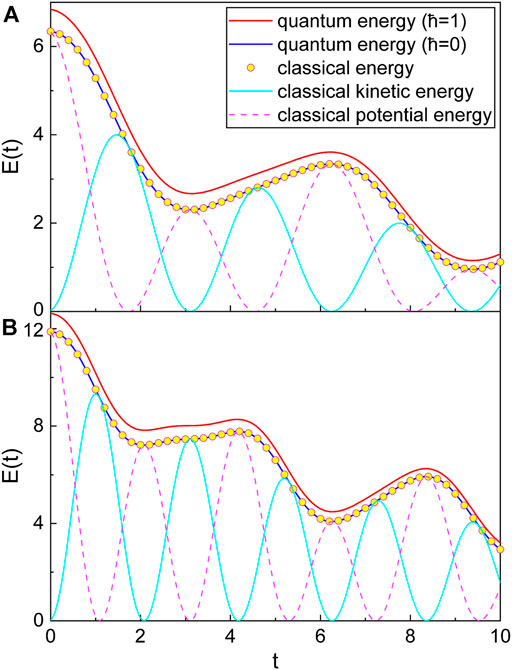
FIGURE 1. Exact quantum energy (red line), quantum energy with
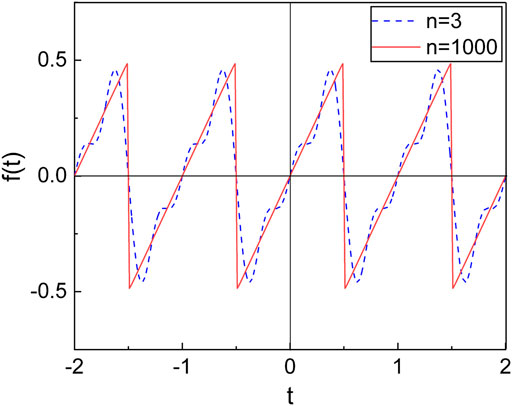
FIGURE 2. Sawtooth driving force
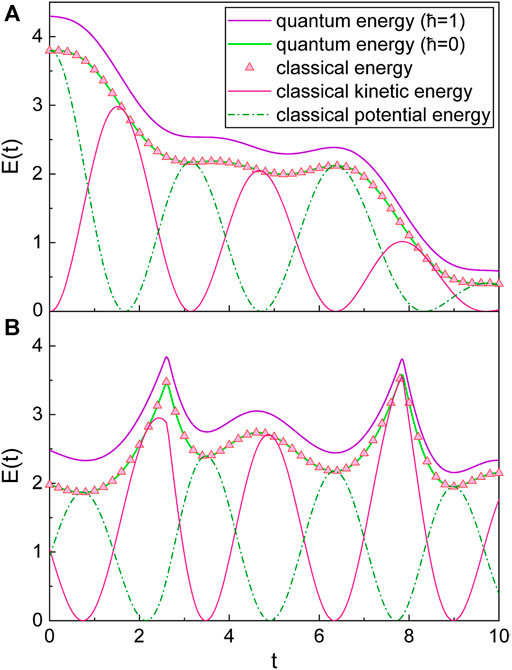
FIGURE 3. Exact quantum energy (violet line), quantum energy with
For further analysis, let us consider the case where the driving force disappears (
where
5 Uncertainty and The Correspondence Principle
An important feature of quantum mechanics, which distinguishes it from classical mechanics, is the appearance of a minimum uncertainty product between the arbitrary two noncommutative operators. One cannot simultaneously know the values of position and momentum with an arbitrary precision from a quantum measurement, while the classical theory of measurement has nothing to do with such a limitation.
The quantum variance of an observable
Because this consequence is independent of the particular solutions,
6 Other Formalisms and Approaches
There are several other quantum formalisms for describing the damped harmonic oscillator, such as the Lindblad dynamics [35–38], non-Hermitian Hamiltonian dynamics [39–41], and the Schwinger action method [15, 42]. Let’s look into the relatively well-known Lindblad dynamics here. Whereas my approach uses invariant operators
Although the momentum given above seems similar to the physical momentum, it is not exactly the same due to the presence of the additional second term.
In particular, Korsch evaluated the expectation value of
If we denote the expectation value of an observable
where
while
Let us now compare the present result with Korsch’s together with the classical one. The expectation value of
The expectation values
with
Figures 4, 5 are the comparison of the time behavior between
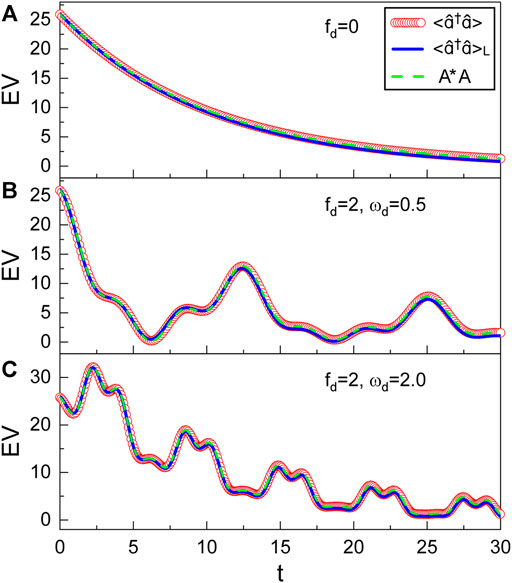
FIGURE 4. Time evolution of the expectation values (EV),
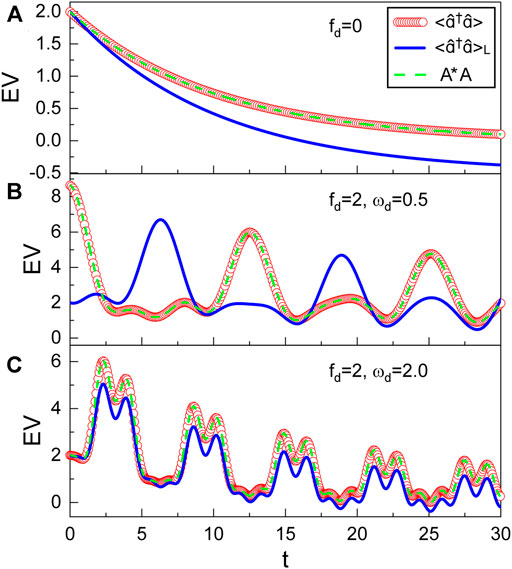
FIGURE 5. Time evolution of
There are lots of different approaches for the classical limit of quantum mechanics with their own viewpoints. The problem of quantum–classical transition has been extensively investigated for the quartic oscillator by Oliveira et al. [29, 43–45]. They argued that quantum–classical correspondence can be achieved via the convergence of three factors, which are large classical actions, the object-environment interaction, and experimentally induced limitations. It was reported by Zurek [46] that the quantum–classical limit is governed by decoherence that takes place through environmental perturbations. As a quantum chaotic system is decohered, it restores classical behavior as a consequence of the destruction of quantum superpositions. Wiebe and Ballentine [47] examined quantum–classical differences by computing the chaotic tumbling of the satellite Hyperion from both classical and quantum points of view regarding the hypothesis of Zurek.
7 Conclusion
Classical limit of quantum mechanics for a driven damped harmonic oscillator has been investigated based on the linear invariant operator. The full wave function of the system was represented in terms of the eigenstate of the linear invariant operator according to the Lewis–Riesenfeld theory [10]. The expectation values of observables, such as position, momentum, and quantum energy, have been derived by using the wave function, and I have compared them with their classical counterparts. From this, it was shown that
The recent trend [48, 49] of the reimplementation of classical mechanics in particle optics using quantum particles is a clear testimony of the close relationship between quantum and classical mechanics. Some essential knowledge of quantum information theory is developed on the basis of classical-like wave properties, while the quantum nature of a physical system is unquestionable especially when nonlocal entanglement is concerned [50]. It may be the very common opinion that every new physical theory should not only precisely describe facts that cannot be covered by existing theories but must also reproduce the predictions of classical mechanics in an appropriate classical limit.
Quantum systems exhibit various nonclassical properties such as entanglement, superposition, nonlocality, and negative Wigner distribution function. While such nonclassicalities are important in the next-generation quantum information science, the description of nonclassical properties is valid and reliable only when the underlying quantum formalism used in such descriptions is precise and complete. A formalism of quantum theory may be acceptable only when it gives classical results in the classical limit (
8 Methods
I considered a time-dependent Hamiltonian, which is composed of the basic CK Hamiltonian and an additional term associated with a time-varying driving force. This Hamiltonian corresponds to a damped driven harmonic oscillator.
The linear invariant operator of the system is constructed from the Liouville–von Neumann equation. The eigenvalue and the eigenstate of the linear invariant operator are derived by solving its eigenvalue equation through a fundamental mathematical procedure. If a system is described by a time-dependent Hamiltonian like the case given here, the eigenstate of the (linear) invariant operator is important because the full wave function of the system is expressed in terms of such an eigenstate [10]. More clearly speaking, the wave function in this case is represented by the eigenstate and a phase factor (see Eq. 6 in the text). Because we now know the formula of the eigenstate, the phase of the wave function can be easily evaluated by means of the Schrödinger equation. In this way, we can derive the full wave function eventually. This wave function is necessary in order to investigate the
The quantum expectation values of observables, such as position, momentum, and the energy operator, are derived using the wave function. By comparing such expectation values with their classical counterparts, the correspondence principle between quantum and classical mechanics is analyzed.
Data Availability Statement
The original contributions presented in the study are included in the article, and further inquiries can be directed to the corresponding author.
Author Contributions
The author confirms being the sole contributor of this work and has approved it for publication.
Funding
This work was supported by the National Research Foundation of Korea(NRF) grant funded by the Korea government(MSIT) (No.: NRF-2021R1F1A1062849).
Conflict of Interest
The author declares that the research was conducted in the absence of any commercial or financial relationships that could be construed as a potential conflict of interest.
Publisher’s Note
All claims expressed in this article are solely those of the authors and do not necessarily represent those of their affiliated organizations, or those of the publisher, the editors and the reviewers. Any product that may be evaluated in this article, or claim that may be made by its manufacturer, is not guaranteed or endorsed by the publisher.
References
1. Planck M. Vorlesungen uber die Theorie der Wärmestralhung. 978-0270103878. New York: Dover Publications (1959).
2. Bohr N. The Theory of Spectra and Atomic Constitution. 978-1107669819. London: Cambridge University Press (1922).
3. Liboff RL. On the Potential x2Nand the Correspondence Principle. Int J Theor Phys (1979) 18(3):185–91. doi:10.1007/BF00670395
4. Man’ko OV, Man’ko VI. Classical Mechanics Is Not the Limit ℏ→0 of Quantum Mechanics. J Russ Laser Res (2004) 25(5):477–92. doi:10.1023/B:JORR.0000043735.34372.8f
5. Huang XY. Correspondence between Quantum and Classical Descriptions for Free Particles. Phys Rev A (2008) 78(2):022109. doi:10.1103/PhysRevA.78.022109
6. Kay KG. Hamiltonian Formulation of Quantum Mechanics with Semiclassical Implications. Phys Rev A (1990) 42(7):3718–25. doi:10.1103/PhysRevA.46.1213
7. Klein U. What Is the ℏ → 0 Limit of Quantum Theory. Am J Phys (2012) 80(11):1009–16. doi:10.1119/1.4751274
8. Oliveira AC. Classical Limit of Quantum Mechanics Induced by Continuous Measurements. Physica A (2014) 393:655–68. doi:10.1016/j.physa.2013.09.025
9. Hen I, Kalev A. Classical States and Their Quantum Correspondence. arXiv:0701015v2 [quant-ph] (2007).
10. Lewis HR, Riesenfeld WB. An Exact Quantum Theory of the Time-dependent Harmonic Oscillator and of a Charged Particle in a Time-dependent Electromagnetic Field. J Math Phys (1969) 10(8):1458–73. doi:10.1063/1.1664991
11. Abdalla MS, Choi JR. Propagator for the Time-dependent Charged Oscillator via Linear and Quadratic Invariants. Ann Phys (2007) 322(12):2795–810. doi:10.1016/j.aop.2007.01.006
12. Choi JR, Zhang S. Quantum and Classical Correspondence of Damped-Amplified Oscillators. Phys Scr (2002) 66(5):337–41. doi:10.1238/Physica.Regular.066a00337
13. Choi JR, Ju S. Properties of the Geometric Phase in Electromechanical Oscillations of Carbon-Nanotube-Based Nanowire Resonators. Nanoscale Res Lett (2019) 14:44. doi:10.1186/s11671-019-2855-8
14. Yeon K-H, Kim S-S, Moon Y-M, Hong S-K, Um C-I, George TF. The Quantum under-, Critical- and Over-damped Driven Harmonic Oscillators. J Phys A: Math Gen (2001) 34(37):7719–32. doi:10.1088/0305-4470/34/37/321
15. Urrutia LF, Hernandez E. Calculation of the Propagator for a Time-dependent Damped, Forced Harmonic Oscillator Using the Schwinger Action Principle. Int J Theor Phys (1984) 23(12):1105–27. doi:10.1007/BF02213423
16. Um C-I, Yeon K-H, George TF. The Quantum Damped Harmonic Oscillator. Phys Rep (2002) 362(2-3):63–192. doi:10.1016/S0370-1573(01)00077-1
17. Caldirola P. Porze Non Conservative Nella Meccanica Quantistica. Nuovo Cimento (1941) 18(9):393–400. doi:10.1007/BF02960144
18. Kanai E. On the Quantization of Dissipative Systems. Prog Theor Phys (1948) 3(4):440–2. doi:10.1007/BF01313310
19. Flores-Hidalgo G, Barone FA. The One Dimensional Damped Forced Harmonic Oscillator Revisited. Eur J Phys (2011) 32(2):377–9. doi:10.1088/0143-0807/32/2/010
20. Choi JR, Nahm IH. SU(1,1) Lie Algebra Applied to the General Time-dependent Quadratic Hamiltonian System. Int J Theore Phys (2006) 46(1):1–15. doi:10.1007/s10773-006-9050-2
21. Schumaker BL. Quantum Mechanical Pure States with Gaussian Wave Functions. Phys Rep (1986) 135(6):317–408. doi:10.1016/0370-1573(86)90179-1
22. Marhic MF. Oscillating Hermite-Gaussian Wave Functions of the Harmonic Oscillator. Lett Nuovo Cim (1978) 22(9):376–8. doi:10.1007/BF02820587
23. Greenberger DM. A Critique of the Major Approaches to Damping in Quantum Theory. J Math Phys (1979) 20(5):762–70. doi:10.1063/1.524148
24. Ehrenfest P. Bemerkung über die angenäherte gültigkeit der klassischen mechanik innerhalb der quantenmechanik. Z Phys (1927) 45(7-8):455–7. doi:10.1007/BF01329203
25. Medjber S, Bekkar H, Menouar S, Choi JR. Testing the Validity of the Ehrenfest Theorem beyond Simple Static Systems: Caldirola-Kanai Oscillator Driven by a Time-dependent Force. Chin Phys B (2016) 25(8), 080301. doi:10.1088/1674-1056/25/8/080301
26. Bolivar AO. In: Quantum-Classical Correspondence: Dynamical Quantization and the Classical Limit. 978-3-662-09649-9. New York: Springer (2004).
27. Colegrave RK, Abdalla MS. A Canonical Description of the Fabry-Perot Cavity. Optica Acta (1981) 28(4):495–501. doi:10.1080/713820584
28. Caves CM, Milburn GJ. Quantum-mechanical Model for Continuous Position Measurements. Phys Rev A (1987) 36(12):5543–55. doi:10.1103/PhysRevA.36.5543
29. Oliveira AC, Oliveira ZT, Correia NS, Complementarity and Classical Limit of Quantum Mechanics: Energy Measurement Aspects. arXiv:1307.0528v1 [quant-ph] (2013).
30. Legleiter J, Park M, Cusick B, Kowalewski T. Scanning Probe Acceleration Microscopy (SPAM) in Fluids: Mapping Mechanical Properties of Surfaces at the Nanoscale. PNAS (2006) 103(13):4813–8. doi:10.1073/pnas.0505628103
31. Hornyak GL, Tibbals HF, Dutta J, Moore JJ. Introduction to Nanoscience & Nanotechnology 978-1420047790. Boca Raton: CRC Press (2009).
32. Soltwisch H. Measurement of Current-Density Changes during Sawtooth Activity in a Tokamak by Far-Infrared Polarimetry. Rev Sci Instrum (1988) 59(8):1599–604. doi:10.1063/1.1140159
33. Choi JR. Interpreting Quantum States of Electromagnetic Field in Time-dependent Linear media. Phys Rev A (2010) 82(5):055803. doi:10.1103/PhysRevA.82.055803
34. Choi JR. Analysis of Quantum Energy for Caldirola-Kanai Hamiltonian Systems in Coherent States. Results Phys (2013) 3(1):115–21. doi:10.1016/j.rinp.2013.06.003
35. Korsch HJ. Lindblad Dynamics of the Damped and Forced Quantum Harmonic Oscillator. arXiv 1908.01187v2 [quant-ph] (2019).
36. Fujii K. Quantum Damped Harmonic Oscillator. In: P Bracken, editor. Advances in Quantum Mechanics. 978-953-51-1089-7. Rijeka: Intech (2013). p. 133–56.
37. Isar A. Uncertainty, Entropy and Decoherence of the Damped Harmonic Oscillator in the Lindblad Theory of Open Quantum Systems. Fortschr Phys (1999) 47(7-8):855–79. doi:10.1002/(SICI)1521-3978(199909)47:7/8¡855::AID-PROP855¿3.0.CO;2-Z
38. Piilo J, Maniscalco S. Driven Harmonic Oscillator as a Quantum Simulator for Open Systems. Phys Rev A (2006) 74(3):032303. doi:10.1103/PhysRevA.74.032303
39. Graefe EM, Höning M, Korsch HJ. Classical Limit of Non-Hermitian Quantum Dynamics—A Generalized Canonical Structure. J Phys A: Math Theor (2010) 43(7):075306. doi:10.1088/1751-8113/43/7/075306
40. Grimaldi A, Sergi A, Messina A. Evolution of a Non-Hermitian Quantum Single-Molecule Junction at Constant Temperature. Entropy (2021) 23(2):147. doi:10.3390/e23020147
41. Nigam K, Banerjee K. Quantum Dynamics of Complex Hamiltonians. arXiv:1602.00157v2 [quant-ph] (2016).
42. Pepore S, Sukbot B. Schwinger Method for Dual Damped Oscillators. Chin J Phys (2015) 53(5):100002. doi:10.6122/CJP.20150803
43. Oliveira AC, Nemes MC, Romero KMF. Quantum Time Scales and the Classical Limit: Analytic Results for Some Simple Systems. Phys Rev E (2003) 68(3):036214. doi:10.1103/PhysRevE.68.036214
44. Oliveira AC, de Faria JGP, Nemes MC. Quantum-classical Transition of the Open Quartic Oscillator: The Role of the Environment. Phys Rev E (2006) 73(4):046207. doi:10.1103/PhysRevE.73.046207
45. Oliveira AC, de Magalhães ARB, Faria JGP. Influence of Experimental Resolution on the Quantum-To-Classical Transition in the Quartic Oscillator. Physica A (2012) 391(21):5082–9. doi:10.1016/j.physa.2012.05.064
46. Zurek WH. Decoherence, Chaos, Quantum-Classical Correspondence, and the Algorithmic Arrow of Time. Phys Scr (1998) 1998(T76):186–98. doi:10.1238/Physica.Topical.076a00186
47. Wiebe N, Ballentine LE. Quantum Mechanics of Hyperion. Phys Rev A (2005) 72(2):022109. doi:10.1103/PhysRevA.72.022109
48. Wang Y-M, Liang J-Q. Repulsive Bound-Atom Pairs in an Optical Lattice with Two-Body Interaction of Nearest Neighbors. Phys Rev A (2010) 81(4):045601. doi:10.1103/PhysRevA.81.045601
49. Hawkes PW. Examples of Electrostatic Electron Optics: The Farrand and Elektros Microscopes and Electron Mirrors. Ultramicroscopy (2012) 119:9–17. doi:10.1016/j.ultramic.2011.11.009
50. Goldin MA, Francisco D, Ledesma S. Classical Images as Quantum Entanglement: An Image Processing Analogy of the GHZ Experiment. Opt Commun (2011) 284(7):2089–93. doi:10.1016/j.optcom.2010.12.057
51. Louisell WH. Quantum Statistical Properties of Radiation. 0-471-54785-9. New York: John Wiley & Sons (1973). p. 104–9.
52. Choi JR. Exact Solution of a Quantized LC Circuit Coupled to a Power Source. Phys Scr (2006) 73(6):587–95. doi:10.1088/0031-8949/73/6/010
Appendix A: Linear Invariant Operator and its Eigenstate
From a straightforward evaluation of the Liouville-von Neumann equation,
using the Hamiltonian given in Eq. 1 in the text, we can easily derive the linear invariant operator
where
where
Appendix B: Expectation Value of the Energy Operator
I present how to evaluate the expectation value of the energy operator. From a minor evaluation with the energy operator using the expression of
where
with
Appendix C: Cantilever System
Description of the cantilever system appears in Ref. 30. If we denote the effective mass of the cantilever as
where
Appendix D: Damped Harmonic Oscillator with a Sawtooth Force
I regard the damped harmonic oscillator to which applied an external sawtooth force with the period
Appendix E: Expectation Values of
The expectation values of
where
where
Here,
Keywords: quantum–classical correspondence, classical limit, Caldirola–Kanai Hamiltonian, quantum energy, invariant operator
Citation: Choi JR (2021) Classical Limit of Quantum Mechanics for Damped Driven Oscillatory Systems: Quantum–Classical Correspondence. Front. Phys. 9:670750. doi: 10.3389/fphy.2021.670750
Received: 22 February 2021; Accepted: 24 May 2021;
Published: 03 August 2021.
Edited by:
Robert Gordon, University of Illinois at Chicago, United StatesReviewed by:
Chitra Rangan, University of Windsor, CanadaAdélcio De Oliveira, Universidade Federal de São João del-Rei, Brazil
Copyright © 2021 Choi. This is an open-access article distributed under the terms of the Creative Commons Attribution License (CC BY). The use, distribution or reproduction in other forums is permitted, provided the original author(s) and the copyright owner(s) are credited and that the original publication in this journal is cited, in accordance with accepted academic practice. No use, distribution or reproduction is permitted which does not comply with these terms.
*Correspondence: Jeong Ryeol Choi, Y2hvaWFyZG9yQGhhbm1haWwubmV0
 Jeong Ryeol Choi
Jeong Ryeol Choi